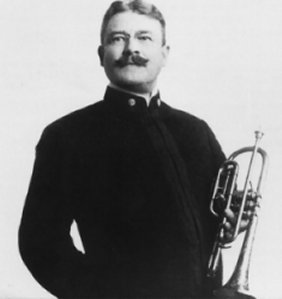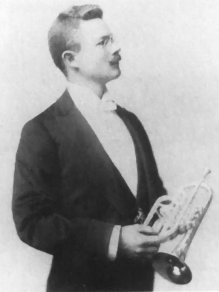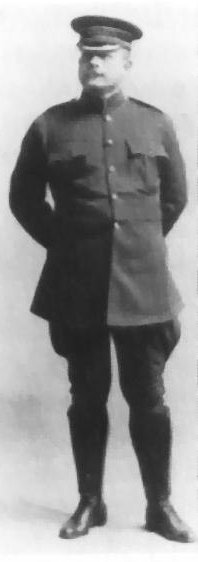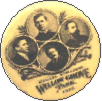|
|
|
The booklet accompanying the CD "CORNET SOLOIST of the Sousa Band HERBERT L. CLARKE"* contains some of the most complete and concise information on Clarke and his music, as well as vintage recordings of his performances. Notes are by Gerald R. Endsley who writes:

Herbert L. Clarke (1867-1945)
"Herbert L. Clarke (1867 – 1945) was an American cornetist, composer, conductor, teacher and one of the most influential musicians at the turn of the 20th Century. As bandsman and featured soloist, he toured the world once, the United States and Canada thirty four times, Europe four times, and performed at the Paris, Chicago, Atlanta, Buffalo, Glasgow, Panama, San Francisco, and St. Louis expositions. In addition, he made gramophone records of a score of his featured solos and conducted several major concert bands, for which he also composed and arranged.
Born on September 12, 1867 in Woburn, Mass., Herbert Lincoln Clarke's ancestors could be traced back to the early settlers of Plymouth, Mass. His father, William was also a composer and organist. Of his four other brothers, Edwin (cornet) and Ernest (trombone) also performed at the professional level. Before he was 12 years of age, his father had also assumed jobs as organist/builder/teacher in Ohio and Indiana before settling in Toronto, Ontario.
 Clarke's early musical instruction was on violin and at 13 years of age he was a second violinist in the Philharmonic Society Orchestra of Toronto. About this time he began to play his brother Ed's cornet and was soon earning fifty cents a night playing in a restaurant band, and later also played in the Queen's Own Regiment Band.
Clarke's early musical instruction was on violin and at 13 years of age he was a second violinist in the Philharmonic Society Orchestra of Toronto. About this time he began to play his brother Ed's cornet and was soon earning fifty cents a night playing in a restaurant band, and later also played in the Queen's Own Regiment Band.
After graduation from high school, the family moved to Indianapolis where he met Walter Rogers (two years older) who would remain a musical associate for the remainder of their lives. Rogers moved to New York to join the Seventh Regimental Band of New York. Although Clarke had been earning money by playing in various organizations, he returned to Toronto to live and work with his brother in business (which paid more than being in local bands.) Here he continued to play and enter solo contests.
He joined the When Clothing Store Band, which won first place at a contest in October of 1886 in Evansville, Indiana. At the afternoon solo competition, he was first to perform, and was somewhat disappointed with his performance, especially after hearing the contestant who followed him. Feeling as if he had disappointed the others in his band, he left the performing area to be alone. Friends searched him out to tell him that he had won – much to his surprise. For the trophy, Henry Distin, a celebrated instrument maker had built a miniature cornet (6 inches long and 5 inches high), presented it to Clarke and asked him to play it. Clarke was surprised at the quality of the instrument, and kept it forever.

 His first fully professional position was as a cornet player with the Citizens' Band of Toronto. He played, taught and studied theory and composition. His brother Ernest was playing trombone with the Patrick Gilmore Band, and when a solo cornet vacancy occurred, Herbert applied, was accepted and toured with the group for several months. His first fully professional position was as a cornet player with the Citizens' Band of Toronto. He played, taught and studied theory and composition. His brother Ernest was playing trombone with the Patrick Gilmore Band, and when a solo cornet vacancy occurred, Herbert applied, was accepted and toured with the group for several months.
 The untimely death of Gilmore in September 1892 left Clarke unemployed, and he returned to New York City where his friend Walter Rogers assisted him in securing free-lance engagements. But in 1893, he joined Sousa and his band in the solo cornet section. Despite the long tenure which Clarke enjoyed with Sousa, the latter was unable to afford his musicians full-time employment, and this allowed Clarke to perform intermittently with the bands of Frederick Innes and the reformed Gilmore Band under Victor Herbert.
The untimely death of Gilmore in September 1892 left Clarke unemployed, and he returned to New York City where his friend Walter Rogers assisted him in securing free-lance engagements. But in 1893, he joined Sousa and his band in the solo cornet section. Despite the long tenure which Clarke enjoyed with Sousa, the latter was unable to afford his musicians full-time employment, and this allowed Clarke to perform intermittently with the bands of Frederick Innes and the reformed Gilmore Band under Victor Herbert.
 He also played second trumpet in the New York Philharmonic, and later principal in the Metropolitan Opera Orchestra. From 1900 to 1921 he performed, tested cornets for the Conn Company and began to write his four instrumental methods for cornet. At this time he also made many solo recordings (many of these recordings were his own compositions) and combined on others with Walter Rogers, Herman Bellstedt and Arthur Pryor. He had heard other fine performs who had continued to perform solos, far after the prime of their careers and although he did play a few selections after he turned 50, he began to concentrate on conducting and teaching. He opened his own school of cornet playing in Chicago.
He also played second trumpet in the New York Philharmonic, and later principal in the Metropolitan Opera Orchestra. From 1900 to 1921 he performed, tested cornets for the Conn Company and began to write his four instrumental methods for cornet. At this time he also made many solo recordings (many of these recordings were his own compositions) and combined on others with Walter Rogers, Herman Bellstedt and Arthur Pryor. He had heard other fine performs who had continued to perform solos, far after the prime of their careers and although he did play a few selections after he turned 50, he began to concentrate on conducting and teaching. He opened his own school of cornet playing in Chicago.
When his wife became ill (1923) they moved to a warmer climate, and soon he accepted the directorship of the Long Beach Municipal Band.
Clarke died on January 30, 1945 and was buried in the Congressional Cemetery in Washington DC near the grave of his lifelong friend, John Philip Sousa. His musical instruments and compositions were donated to the Univ. of Illinois through the efforts of A. A. Harding, director of bands who was a friend to both Sousa and Clarke.
Clarke's contribution to cornet playing was primarily a refinement of style focusing on lyricism and melodic flow, even in extremely difficult passages. Later, other cornet soloists reflected this style and continued it into another generation."
Program Notes by Gerald R.
Endsley and Frederick Williams
*The recordings reproduced on the CD were taken from the double-sided Victor, Columbia and Brunswick recordings made by Clarke. These contain some of the most famous virtuoso solos ever written as performed by the composer. Serious students are encouraged to add this CD to their collection.
"CORNET SOLOIST of the Sousa Band HERBERT L. CLARKE"
Crystal Records Historical Series CD 450 - 1996
28818 NE Hancock Rd.
Camas, WA 98607
Back to Herbert L. Clarke
Return to Performers
|
|



 Clarke's early musical instruction was on violin and at 13 years of age he was a second violinist in the Philharmonic Society Orchestra of Toronto. About this time he began to play his brother Ed's cornet and was soon earning fifty cents a night playing in a restaurant band, and later also played in the Queen's Own Regiment Band.
Clarke's early musical instruction was on violin and at 13 years of age he was a second violinist in the Philharmonic Society Orchestra of Toronto. About this time he began to play his brother Ed's cornet and was soon earning fifty cents a night playing in a restaurant band, and later also played in the Queen's Own Regiment Band. 